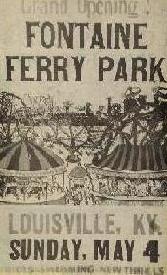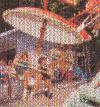![]() Park History
Park History

John Willard, the designer of Palisades Park in New York, conceived the idea of Fontaine Ferry Park. The owners, The Park Circuit and Realty Company, began construction of the amusement park in 1903. At that time, there were several methods of transportation to Fontaine Ferry Park, the most common being steamboats. Fontaine Ferry's landing predated the first Ohio River bridge by 70 years.
During the park's first years, its success was so overwhelming that at least seven other amusement parks sprung up over the "Kentuckiana" area. Some of these were Sennings Park Zoo, White City, Ninaweb Park, Liberty Grove, Hammers Park, Glenwood Park, Rose Island, and Kiddieland Amusement Park. Fontaine Ferry's competition didn't last long. All of these parks closed within three years after their opening.
Over the years there were four major roller coasters in the park, all on the same site. They were: The Scenic Railway, The Racing Derby, The Velvet Racer, and The Comet. In 1937 the flood wiped out The Velvet Racer, but did virtually no damage to the rest of the park. This was because the roller coaster was built in the flood plain, whereas the rest of the park was not.
Problems with Fontaine Ferry Park began in 1941. On November 7 of that year, allegations of the rides being too rough began. People were cited for standing up on the roller coasters. The Comet roller coaster tossed a rider while two others were killed on the Racing Derby. Another child was thrown from one of the smaller rides inside a building. Roller skaters were even hurt along with a swimmer. An aerialist fell 25 feet, missed the net, but was not hurt. Also during this time accusations were made that the waters of the Tunnel of Love were infested with snakes. The story was believed by the public and Fontaine Ferry was forced to replace the tunnel with the Turnpike. Later, the snake story was proven false.
Fontaine Ferry Park was faced with problems far greater than rough rides during its 64 year existence. In 1964 a man named William Dady was prohibited from entering the pool because of his race. Many of the other park visitors were afraid of being in the pool with a "Negro." Dady and his friends wanted to come to Fontaine Ferry and swim but were told that the pool was a private club and that city laws of integration did not apply. By forcing his way in, Dady and his friends entered the pool a second time. After being removed again, they decided to obey the court order. This all took place near the end of July 1964. By August 9, the court order was extended to keep Dady out for a longer period of time. The season of pool operation ended before an "anti-discrimination" law or court order could be issued.
On opening day, May 4, 1969, many youths attacked workers and looted Fontaine Ferry Park. Many items were destroyed, especially the portable food stands and some buildings. The damage cost the park $18,000 and took 25 policemen to handle. The park closed that day, never to reopen as Fontaine Ferry Park. The buildings and rides sat idle for some time, only to reopen as another amusement park. Opened in 1972, the aptly named "Ghost Town on the River" lasted only three years. The area was also later renamed River Glen Park, but its duration was even shorter: one year.


Pictured on the right is the Hrubetz Paratrooper, which was relocated to Knoebels Amusement Park in 1970. Although these are the only two visual images of Fontaine Ferry Park remaining, the countless mental images and souvenirs will live on forever.
The history of Captain Aaron Fontaine
© 1992, reproduced 1994, updated 2015 - Jennifer Kaiser (DiNoto). All Rights Reserved.